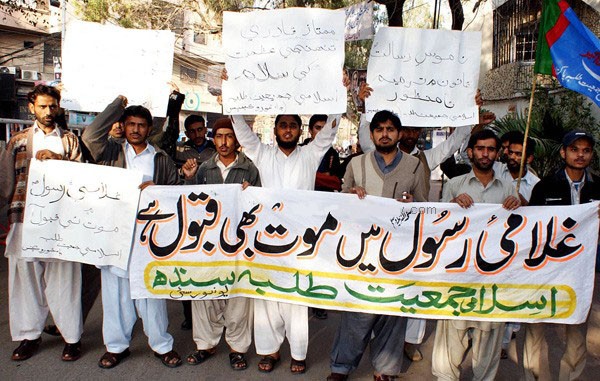
How a Muslim came to be defined

Khatam-i-Nubuwwat (the finality of Prophet-hood) is under the spotlight yet again. That concept holds centrality in defining a Muslim in Pakistan’s religio-political history. Therefore, a serious omission on the part of Muslim League-N while drafting an amendment to the existing law, just a couple of week ago, got the party leadership an extraordinary media flak.
The sensitivity that Khatam-i-Nubuwwat carries among the general public is enormous to say the least. Luckily for PML-N, the reaction from the clergy and right wing sections of the political spectrum remained largely contained. No heads were rolled. The ‘wrong’ committed was rectified forthwith.
There was no major ruckus because of PML-N’s long standing nexus with the forces of ultra right. That nexus lasts even until this very time, through the good offices of several of its members including the Punjab’s law minister. Had such faux paus been committed by some party with liberal political overtones, the consequences for that party would be extremely perilous.
Given the sensitive nature of Khatam-i-Nubuwwat, its evolution as a central determinant warrants in-depth contemplation and analysis. That is imperative in order to make better sense of its significance.
Until the early modern period of Muslim intellectual history of South Asia, Muslim rule was in existence; therefore question like the definition of a Muslim never arose. The religious culture revolved around the empire and dargah (Sufi Shrine), the influence of which had been articulated in the social plurality. Both of these institutions allowed certain space for the co-existence of multiple socio-cultural identities. While in the state of political ascendency, nations and communities generally don’t bother much about rituals or the defining features. Emphasis on such performative acts or doing a definition is in itself the outcome of modernity and they are in essence exclusionary.
Anyhow from the eighteenth century onwards, the plural ethos began to erode giving way to fissures splitting the groups and sections apart. But in the nineteenth century, the political landscape of South Asia marked tectonic changes. The onset of the British rule brought with it, its own, what Bernard Cohen calls, ‘the technologies of Control’. Its classificatory mechanism which the British deployed in the affairs of governance, every subject had to have some definition. Therefore Muslim treated as a subject needed a definition too, particularly when the Anglo-Muhammadan Law was being re-formulated de novo. Muslim was defined as the one who could recite Kalama-i-Tayaba.
But that defining feature was rendered inadequate when in the wake of Christian missionaries proselytising of their faith, the local religious communities were made conscious of their vulnerabilities.
Thus the process of introspection began among Muslims of South Asia which resulted in multiple responses like modernist, traditionalist and heterodox. Mohammadan Anglo Oriental College Aligarh under Sir Syed Ahmad Khan represented the Modernist response, suggesting Muslims to embrace Western values and education. Maulvi Chiragh Ali and Sayed Ameer Ali too were modernists in their orientations. They tried to persuade Muslims to equip themselves with modern education. They also felt the need to re-interpret the foundation religious texts in the light of newly emergent situation.
Darul Uloom Deoband resorted to puritanical ways and means for the Muslims to address the situation. Later on Barelvis and Ahl-i-Hadith too came to represent other variants of Islamic traditionalism.
Mirza Ghulam Ahmad and his followers (Ahmadis) were deemed as a heterodox faction. Mirza Ghulam Ahmad is alleged to have claimed the status of a Prophet, which is in contravention to the established belief of the Muslims that Prophet-hood, came to an end with the Prophet Muhammad (PBUH). First he claimed to be a Mujadid (reviver) but then he elevated himself to the status of a Prophet. Thus Muslim Ulema were greatly irked by such a claim. Important here to mention is that the first takfiri fatwa issued against Ahmadis was with respect to their views on Jihad. Mirza Ghulam Ahmad pronounced nullification of the institution of Jihad particularly against the British. He also asked his followers to stay aloof from the mainstream Muslims. Thus the exclusion on the basis of religion was initiated by the Ahmadis themselves.
But the variable which urged Muslims to come up with a new definition was Mirza Ghulam Ahmad’s pronouncement whereby he was zillinabi. It is very interesting that the new definition of a Muslim was hammered out by none other than Allama Iqbal in his essay entitled Islam and Ahmadism. That is quite a dense piece of writing and seemed an appended piece of The Reconstruction of Religious Thought in Islam. That probably was the reason that such a venture was far too much for any religious Alim to undertake.
The important aspect here is the fact that definition in itself is an act of modernity. That was the reason any alim steeped in religious traditionalism was not expected to perform such a task.
Iqbal put forward three fundamental postulates namely Unity of God (Tauheed), Divinity of the Quran (Quran as a word of Allah) and the Finality of Prophet-hood. For many years Iqbal’s essay (Islam and Ahmadism) remained hidden and Ulema particularly had no clue of it whatsoever. Moreover, under the British Raj the concept of Khatam-i-Nubuwwat’s circulation and currency remained very limited. It was only after Pakistan’s establishment that it emerged as an extremely potent slogan. Majlis-i-Ahrar-i-Islam was the chief exponent of Khatam-i-Nubuwwat. The anti-Pakistan Ahrar tried to make itself politically relevant through that concept. Thus they established an organisation by the name of Majlis-i-Tahfuz-i-Khatam-i-Nubuwwat (MTKN) in January 1949. MTKN’s anti Ahmadi tirade and agitation that shook the very foundations of Pakistani state is a very crucial episode of Pakistan’s history. Pakistani state barely put down that agitation by imposing Martial Law with General Azam Khan as the commander. (to be continued)